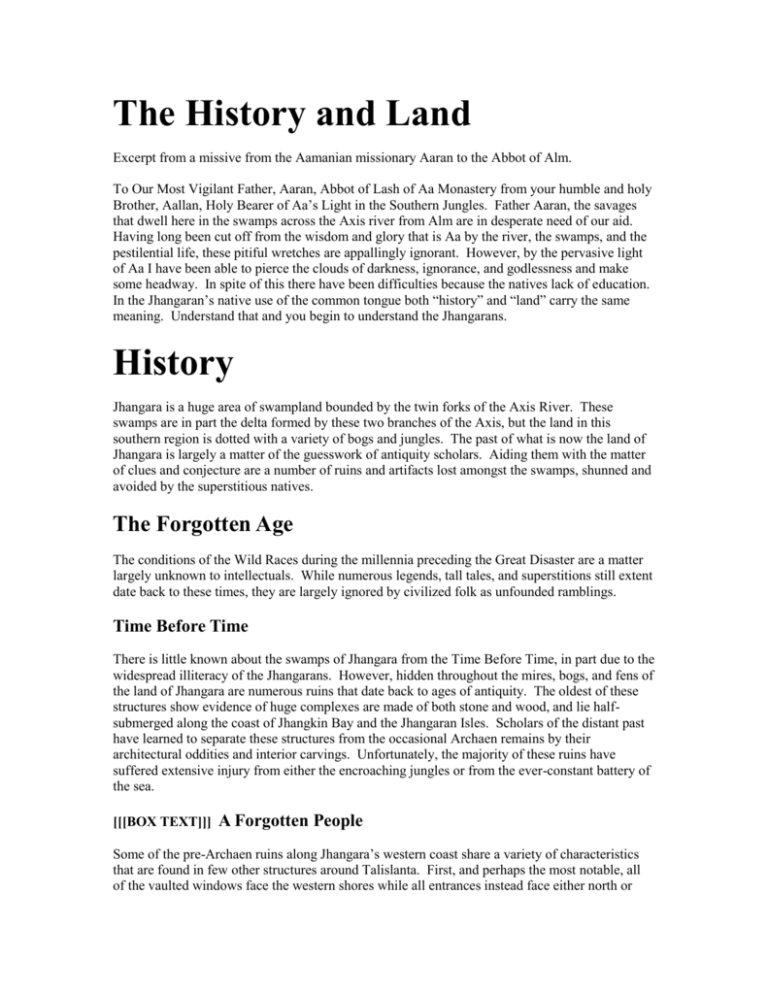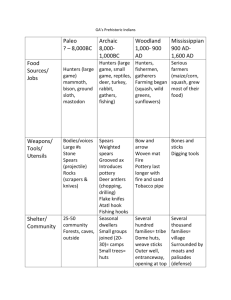Jhangara before - PeeDeePages.com
advertisement

The History and Land Excerpt from a missive from the Aamanian missionary Aaran to the Abbot of Alm. To Our Most Vigilant Father, Aaran, Abbot of Lash of Aa Monastery from your humble and holy Brother, Aallan, Holy Bearer of Aa’s Light in the Southern Jungles. Father Aaran, the savages that dwell here in the swamps across the Axis river from Alm are in desperate need of our aid. Having long been cut off from the wisdom and glory that is Aa by the river, the swamps, and the pestilential life, these pitiful wretches are appallingly ignorant. However, by the pervasive light of Aa I have been able to pierce the clouds of darkness, ignorance, and godlessness and make some headway. In spite of this there have been difficulties because the natives lack of education. In the Jhangaran’s native use of the common tongue both “history” and “land” carry the same meaning. Understand that and you begin to understand the Jhangarans. History Jhangara is a huge area of swampland bounded by the twin forks of the Axis River. These swamps are in part the delta formed by these two branches of the Axis, but the land in this southern region is dotted with a variety of bogs and jungles. The past of what is now the land of Jhangara is largely a matter of the guesswork of antiquity scholars. Aiding them with the matter of clues and conjecture are a number of ruins and artifacts lost amongst the swamps, shunned and avoided by the superstitious natives. The Forgotten Age The conditions of the Wild Races during the millennia preceding the Great Disaster are a matter largely unknown to intellectuals. While numerous legends, tall tales, and superstitions still extent date back to these times, they are largely ignored by civilized folk as unfounded ramblings. Time Before Time There is little known about the swamps of Jhangara from the Time Before Time, in part due to the widespread illiteracy of the Jhangarans. However, hidden throughout the mires, bogs, and fens of the land of Jhangara are numerous ruins that date back to ages of antiquity. The oldest of these structures show evidence of huge complexes are made of both stone and wood, and lie halfsubmerged along the coast of Jhangkin Bay and the Jhangaran Isles. Scholars of the distant past have learned to separate these structures from the occasional Archaen remains by their architectural oddities and interior carvings. Unfortunately, the majority of these ruins have suffered extensive injury from either the encroaching jungles or from the ever-constant battery of the sea. [[[BOX TEXT]]] A Forgotten People Some of the pre-Archaen ruins along Jhangara’s western coast share a variety of characteristics that are found in few other structures around Talislanta. First, and perhaps the most notable, all of the vaulted windows face the western shores while all entrances instead face either north or east. Additionally, all of these buildings contain religious iconography or evidence of its past presence. Typically found as carvings or as bas relief, the vast majority of these seem to depict the seas in a negative context, ostensibly prohibiting travel across the waves. Furthermore, some of the remaining figures resemble strange creatures that seem to be a mixture of both Man and Fish or some other aquatic beast. While they do not resemble any currently living creatures found in Talislanta, some scholars have likened them to either the Sun-Ra-San of the far East or the Imrians of the Southern Rim. Whoever or whatever previously lived in these ruins may have either feared these creatures or perhaps built these extensive fortress-temples as a way to guard against those terrors from the sea. [[[END BOX TEXT]]] Of the structures built that have survived, many of them display evidence of great architectural skill. Rooms and passageways seem to flow one into another in an almost organic fashion. The smoothly flowing lines of these buildings are largely constructed out of stone, although constructions combining rock and coral have been found. The various niches and crannies throughout these buildings seem to suggest that the populace used scintilla much as modern Talislantans do - as a system of illumination. In addition to tools, including weapons, made out of carved bone, shell, and coral, explorers have found evidence that the natives were literate. Artifacts such as bone quills, carved ink-wells, and the occasional carved inscription, despite being largely illegible, further underline this claim. The majority of treasure looted from these sites prominently display all manner of pearls, including the rare violet pearl from the quaga. Found mostly along the coastal swamps, inlets, and grottoes, it is obvious that the inhabitants of these ruins were a people whose lives depended upon the sea. Depending upon the strength of season rains and current tides, finding these ruins can be difficult. In fact, many of them are now completely submerged beneath the waves. [[[BOX TEXT]]] The First Folk - A Watery Origin? The odd coral and stone constructions, the location of buildings right along the water’s edge, and the presence of writing that highly resembles Piscine seems to hint that the inhabitants of these ruins, whether they were First Folk or one of the Wild Races, were at the least a semi-aquatic race. Indeed, given the evidence it seems entirely possible that they were almost entirely aquatic and only came to the surface for brief periods of time. Precisely why they came to the surface, if this is indeed the case, remains a mystery. [[[END BOX TEXT]]] The Archaen Ages Early Archaens found these coastal fortress-temples and as they grew ever more secure in their magical prowess came to heed the warnings of the inhabitants, a race whose name is now lost to history. As the Archaens grew in strength, challenged and overcame first the First Folk and then the Wild Races, this race declined. Eventually as the Archaens reached their peak, these structures were abandoned. Some pioneering Archaens went so far as to loot the abandoned structures, opening up long buried tombs and chambers beneath the temples. While they may have found great magical lore or artifacts in these places, those who did so did not record precisely which shrines yielded hidden knowledge. In addition to the ancient temple-forts, the Archaens themselves left behind a few relics of their own. Like the older structures, the Jhangarans regard these ruins as forbidden locales and do not venture into them. Although the Archaens were largely known and remembered for their amazing floating city- states, in the days of their magical infancy they too were prisoners of the earth just as the Landborne that they would later one day shun. It was along the western end of Talislanta that the first Archaens ventured forth against the First Folk, and even though the swamps were not their first home there were Archaens who ventured there in various effort to carve out empires of their own. While there would be later Archaen ruins of a slightly more permanent nature and decidedly more magically powerful, many of these early wooden structures wound up being submerged in the rising tides and accumulating silt washed down river. It is possible that some of them remain intact buried in the bogs and river sediments, but for the most part the Archaens left little impact on Jhangara. It was also during the Archaen Ages that the Jhangarans first began to settle the land with which they share a name. Precisely where the Jhangarans originated is unknown. Amongst the records of the Archaens there is little evidence to be found. In one account there is no mention of anything at all except the expurgated records of the abandoned temple-fortresses, in the next the Jhangarans are simple indicated to be the inhabitants of the swamps of the area. The Jhangarans themselves have a number of different accounts of their origins. The oldest, and perhaps the oddest, origin stories of the Jhangarans claim that their people were born in a harsh and violent land far to the west. After generations of suffering and hardship, the people begged their Creator to save them. Their Creator, an air goddess whose name is lost to time, answered their prayers and transported them across a great and vast sea expending a great deal of its power. Having deposited them on the banks of the Axis River, the Jhangarans were admonished about invoking the power of their Creator and told that if any Jhangaran crossed the waves they would lose their religion. As the modern Jhangarans have no real organized religion, merely a handful of primeval traditions and passed-down superstitions, it can be assumed perhaps that whatever strictures were laid upon them in the past may have taken effect. A differing legend claims kinship, however distant, with a race of jungle-dwellers in the distant east. Fearing the rage and violence of their brother-tribe, the Jhangarans found a way to wash away those violent emotions. In so doing, the bright and vibrant coloration so common to jungle creatures washed from their skin and they took on the hues of the calm and patient earth. Viewing their now bland cousins as cowards and traitors, the more violent of the two tribes attacked repeatedly, driving the Jhangarans further and further west every few years. A third story, one that carries a bit more weight with modern scholars, is that the Jhangarans were an early, and failed, biomantic hybridization experiment. In attempting to create a hardy supply of servants, perhaps for labor, warfare, or simple food-production, the Jhangarans were created by mixing Ahazu, Archaen, and other unknown stock. Proponents of this theory point to the Monad as being a later, more successful, version of the same experimentation. The easy pliability and natural hardiness of the Jhangarans would be consistent with a created slave-race. Critics of this theory point to the Jhangarans lack of any of the extra-ordinary abilities that commonly occur amongst the specialized servitor-races created by the Archaens and their descendants. The most credible story is perhaps also the simplest. The Jhangarans were once originally a tribe of Wild Folk, most likely the tribe known as the Running Spears. This tribe was known to frequent the south-western jungles and swamps of the continent. The Running Spears were known to utilize ambushes, hit and run attacks, and theft in order to steal the essential things they needed to survive. Most of the Sub-Men tribes despised the Running Spears, not out of fear but due to loathing; even amongst the Wild Folk the Running Spears were extremely primitive and superstitious. When the Tirshata, a hero of great renown amongst the Wild Folk, united the disparate tribes to fight the Archaens, the Running Spears flocked to his call. Serving as advance scouts, guides, and trappers they were able to give the Wild Folk a slight, if decidedly helpful, edge against the Archaens. After the Tirshata disappeared, the Running Spears were overwhelmed. Their witchdoctors and shamans claimed that his disappearance was the forewarning of a horrendous catastrophe. The Running Spears fled as far as they could, back to the swamps and jungles of their former homes. Given that the Jhangarans fit all the pertinent descriptions of the Running Spears, it is safe to assume that the Jhangarans are a still primitive tribe of Wild Folk that have utilized their time-honed skills to survive in some of Talislanta’s most unforgiving jungles. The Jhangarans have in part adapted a lifestyle based on a much smaller territory than that prowled by the Running Spears. Although the Jhangarans do move from place to place, they also dwell in a number large villages in addition to smaller, temporary ones that move with the seasons. The Great Disaster It is believed that the Jhangarans were much more numerous prior to the disaster. While their tribes and culture were widespread along the southern coastal regions from what are now the Monastic Hills to Barbatus Bay, after the Great Disaster they were only to be found in the southwest. Reversing some of the Jhangarans’ varied creation myths, multiple scholars have claimed that the Ahazu are derived from the Jhangarans, altered by the magical energies released during the catastrophe. What is known about south-western Talislanta following the Great Disaster is that the overall sea level for the area fell increasing the number of low-lying bogs and marshes in the area. This falling of the sea also served to expose numerous ruins and create copious small narrow bays and islets that would later serve to hide innumerable pirates, scavengers, and ne’er-do-wells in the centuries to come. Godless Savages Whoever they may have been, the ancestors of the Jhangarans were a very devout and religious people who worshiped a small pantheon of deities. The tribesmen believed that these remote but powerful beings could not directly interact with the world without causing extreme calamitous changes. Instead, these deities communicated their desires and wishes through signs and portents. When the tribesmen correctly interpreted these symbols, they were rewarded; when they failed to interpret them properly the gods displeasure was obvious. Furthermore, the meaning of any particular sign was subject to various interpretations, thus preventing any sort of standard set of meanings. When the Jhangarans encountered the Archaens it seemed that these strangers possessed the powers of the gods. Unused to magic, the Jhangarans who witnessed the wonders of the Archaens were astounded and amazed. As a result, many of them began to claim that their elders’ stories of powerful deities were simply fictional stories. Others







